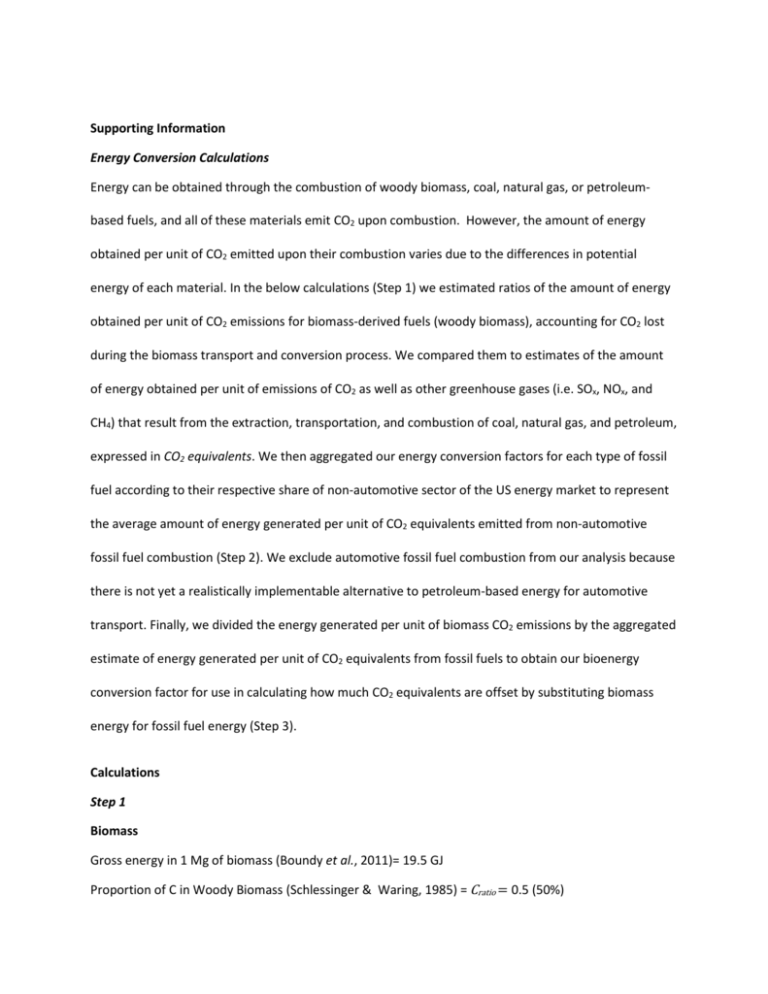gcbb1173-sup-0009-BioenergyCalculations
advertisement

Supporting Information Energy Conversion Calculations Energy can be obtained through the combustion of woody biomass, coal, natural gas, or petroleumbased fuels, and all of these materials emit CO2 upon combustion. However, the amount of energy obtained per unit of CO2 emitted upon their combustion varies due to the differences in potential energy of each material. In the below calculations (Step 1) we estimated ratios of the amount of energy obtained per unit of CO2 emissions for biomass-derived fuels (woody biomass), accounting for CO2 lost during the biomass transport and conversion process. We compared them to estimates of the amount of energy obtained per unit of emissions of CO2 as well as other greenhouse gases (i.e. SOx, NOx, and CH4) that result from the extraction, transportation, and combustion of coal, natural gas, and petroleum, expressed in CO2 equivalents. We then aggregated our energy conversion factors for each type of fossil fuel according to their respective share of non-automotive sector of the US energy market to represent the average amount of energy generated per unit of CO2 equivalents emitted from non-automotive fossil fuel combustion (Step 2). We exclude automotive fossil fuel combustion from our analysis because there is not yet a realistically implementable alternative to petroleum-based energy for automotive transport. Finally, we divided the energy generated per unit of biomass CO2 emissions by the aggregated estimate of energy generated per unit of CO2 equivalents from fossil fuels to obtain our bioenergy conversion factor for use in calculating how much CO2 equivalents are offset by substituting biomass energy for fossil fuel energy (Step 3). Calculations Step 1 Biomass Gross energy in 1 Mg of biomass (Boundy et al., 2011)= 19.5 GJ Proportion of C in Woody Biomass (Schlessinger & Waring, 1985) = Cratio = 0.5 (50%) Proportion of fossil fuel energy expended in the transport of a given amount of biomass energy (Hamelinck et al., 2005) = Etransport = 0.2 (20%) Energy conversion efficiency of woody biomass power plant (Bergman & Zerbe, 2008) = = 0.25 Gbiomass = gross energy in 1 Mg of biomass C = 19.5 GJ/Cratio =39.00 GJ Mg C-1 Tbiomass = energy required for transporting 1 Mg of biomass C = Gbiomass * Etransport = 7.80 GJ Mg C-1 Ebiomass = electricity generation for biomass = Gbiomass - Tbiomass * = 8.00 GJ Mg C-1 Conversion of GJ Mg C-1C to GJ Mg C-1 CO2: 8.00 GJ Mg C-1 * 0.28 = 2.18 GJ/ Mg CO2 (or equivalents) Coal (71% of electricity generated from fossil fuels in US (Energy Information Administration, 2011)) Ecoal = net electricity generation for coal (Jaramillo et al., 2007) = 2270 lbs CO2 equivalents/MWh = 1030 kg CO2 equivalents/3.6 GJ = 3.50 GJ/Mg CO2 equivalents Natural Gas (27% of electricity generated from fossil fuels in US (Energy Information Administration, 2011)) Egas = net electricity generation for natural gas(Jaramillo et al., 2007) = 1400 lbs CO2 equivalents/MWh = 635 kg CO2 equivalents/3.6 GJ= 5.67 GJ/Mg CO2 equivalents Crude Oil/Petroleum (2% of electricity generated from fossil fuels in US (Energy Information Administration, 2011)) Epetrol = net electricity generation for crude oil/petroleum(Gray et al., 2007) = 550 lbs CO2/MWh = 249 kg CO2 equivalents/3.6 GJ= 14.45 GJ/Mg CO2 equivalents Proportion of Electricity Generated from Fossil Fuels in US (2009) Coal Energy Proportion(Energy Information Administration, 2011) = Pcoal = 0.71 (71%) Natural Gas Electricity Proportion(Energy Information Administration, 2011) = Pgas = 0.27 (27%) Petroleum Electricity Proportion(Energy Information Administration, 2011) =Ppetrol = 0.02 (2%) Step 2 Aggregated estimate of electricity generation per unit of CO2 equivalents from fossil fuel sources: = Efossil Efossil = 4.30 GJ / Mg CO2 equivalents Step 3 Calculation of Bioenergy Conversion Factor = References Bergman R, Zerbe J (2008) Primer on Wood Biomass for Energy. Boundy B, David SC, Wright LL, Badger PC, Perlack R (2011) Biomass Energy Data Book. Energy Information Administration USDOE (2011) Electric Power Sector Energy Consumption, 19492009. Gray D, White C, Tomlinson M, Ackiewicz M, Schmetz E, Winslow J (2007) Increasing Security and Reducing Carbon Emissions of the U.S. Transportation Sector: A Transformational Role for Coal with Biomass. Hamelinck CN, Suurs RaA, Faaij APC (2005) International bioenergy transport costs and energy balance. Biomass & Bioenergy, 29, 114-134. Jaramillo P, Griffin WM, Matthews HS (2007) Comparative life-cycle air emissions of coal, domestic natural gas, LNG, and SNG for electricity generation. Environmental Science & Technology, 41, 6290-6296. Schlessinger WH, Waring RH (1985) Forest Ecosystems: Concepts and Applications.








